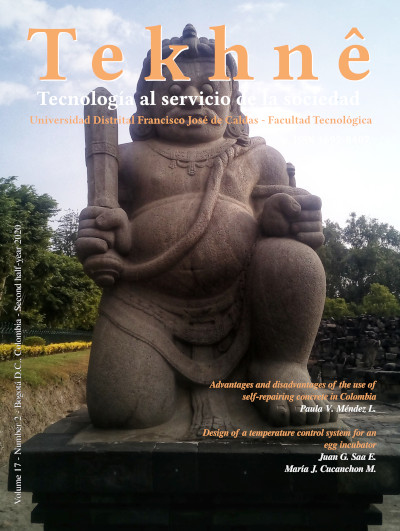Publicado:
2020-12-25Número:
Vol. 17 Núm. 2 (2020): Revista TekhnêSección:
ArtículosConcretos permeables - conservacion del agua
Permeable concrete - water conservation
Palabras clave:
Concrete absorption, infiltration, permeable, pervious concrete, water (en).Palabras clave:
Absorción del concreto, permeable, infiltración, agua (es).Descargas
Resumen (es)
Se analiza el uso de los concretos permeables en la infraestructura para la movilidad urbana. Además, se presentan sus propiedades, cuáles podrían ser sus usos, y el tipo de infiltración que puede llegar a tener. El diseño de pavimentos presenta una condición de divergencia, atiende a la resistencia, pero no a la preservación del agua. En este sentido se presenta una investigación sobre alternativas que sirvan como método de preservación y además reutilización. El objetivo es que las mismas no solo permitan el tránsito vehicular, sino que pueda transportar el agua internamente, y hacer que llegue al lugar deseado. Se concluye que para una movilidad urbana sustentable y rentable, la utilización de concretos permeables debe ser una alternativa, ya que atienden a requerimientos de infraestructura, manejo y preservación del recurso agua. También se requieren acciones para mejorar y ampliar las posibilidades de utilización de los pavimentos permeables, dadas sus limitaciones.
Resumen (en)
The use of pervious concrete in urban mobility infrastructure is analyzed. In addition, its properties are presented, as well as its possible uses and the type of infiltration it can have. The design of pavements presents a divergence condition, it attends to resistance, but not to water preservation. In this sense, research on alternatives that serve as a method of preservation and reuse is presented. The objective is that they not only allow vehicular traffic, but can also transport water internally, and make it reach the desired place. It is concluded that for sustainable and profitable urban mobility, the use of permeable concrete should be an alternative since it meets the requirements of infrastructure, management, and preservation of water resources. Actions are also required to improve and expand the possibilities of using permeable pavements, given some of their limitations.
Referencias
Aryan, K., Gupta, A., & Agrawal, K. (2019). Permeable roads and pavements for ground water replenishing water drinking concrete. International Journal of Recent Technology and Engineering, 8(2S8), 941–945. https://doi.org/10.35940/ijrte.b1179.0882s819
Chen, J., Chu, R., Wang, H., Zhang, L., Chen, X., & Du, Y. (2019). Alleviating urban heat island effect using high-conductivity permeable concrete pavement. Journal of Cleaner Production, 237(2019), 117722. https://doi.org/10.1016/j.jclepro.2019.117722
Chen, L.-M., Chen, J.-W., Chen, T.-H., Lecher, T., & Davidson, P. (2019). Measurement of permeability and comparison of pavements. Water, 11(3), 444. https://doi.org/10.3390/w11030444
Kia, A., Wong, H. S., & Cheeseman, C. R. (2018). Defining clogging potential for permeable concrete. Journal of Environmental Management, 220(2018), 44–53. https://doi.org/10.1016/j.jenvman.2018.05.016
Kim, Y. J., Gaddafi, A., & Yoshitake, I. (2016). Permeable concrete mixed with various admixtures. Materials & Design, 100(2016), 110–119. https://doi.org/10.1016/j.matdes.2016.03.109
Lin, Z., Yang, H., & Chen, H. (2019). Influence of fillers on the removal of rainwater runoff pollutants by a permeable brick system with a frame structure base. Water Science and Technology, 80(11), 2131–2140. https://doi.org/10.2166/wst.2020.021
Masum, A., & Manzur, T. (2019). Delaying time to corrosion initiation in concrete using brick aggregate as internal curing medium under adverse curing conditions. Construction and Building Materials, 228(2019), 116772. https://doi.org/10.1016/j.conbuildmat.2019.116772
Razzaghmanesh, M., & Borst, M. (2019). Long-term effects of three types of permeable pavements on nutrient infiltrate concentrations. Science of The Total Environment, 670(2019), 893–901. https://doi.org/10.1016/j.scitotenv.2019.03.279
Rohr-Suchalla, K., & Wolfgramm, B. (2018). Wasserundurchlässige bauwerke aus beton. Betonund Stahlbetonbau, 113(2018), 155–161. https://doi.org/10.1002/best.201700079
Sehgal, K., Drake, J., Seters, T., & Linden, W. V. (2018). Improving restorative maintenance practices for mature permeable interlocking concrete pavements. Water, 10(11), 1588. https://doi.org/10.3390/w10111588
Şengün, E., Alam, B., Shabani, R., & Yaman, I. (2019). The effects of compaction methods and mix parameters on the properties of roller compacted concrete mixtures. Construction and Building Materials, 228(2019), 116807. https://doi.org/10.1016/j.conbuildmat.2019.116807
Wu, H., Sun, B., Liu, Z., & Yin, J. (2017). Laboratory-simulated investigation on thermal behaviours of permeable concrete pavements. Road Materials and Pavement Design, 18(sup3), 97–108. https://doi.org/10.1080/14680629.2017.1329865
Cómo citar
APA
ACM
ACS
ABNT
Chicago
Harvard
IEEE
MLA
Turabian
Vancouver
Descargar cita
Visitas
Descargas
Licencia
Derechos de autor 2020 Hector Hernando Jaimes Burgos, Mayur A. Tobar A.

Esta obra está bajo una licencia internacional Creative Commons Atribución-NoComercial-SinDerivadas 4.0.
Aquellos autores/as que tengan publicaciones con esta revista, aceptan los términos siguientes:
- Los autores/as conservarán sus derechos de autor y garantizarán a la revista el derecho de primera publicación de su obra, el cuál estará simultáneamente sujeto a la Licencia de reconocimiento de Creative Commons que permite a terceros compartir la obra siempre que se indique su autor y su primera publicación esta revista.
- Los autores/as podrán adoptar otros acuerdos de licencia no exclusiva de distribución de la versión de la obra publicada (p. ej.: depositarla en un archivo telemático institucional o publicarla en un volumen monográfico) siempre que se indique la publicación inicial en esta revista.
- Se permite y recomienda a los autores/as difundir su obra a través de Internet (p. ej.: en archivos telemáticos institucionales o en su página web) antes y durante el proceso de envío, lo cual puede producir intercambios interesantes y aumentar las citas de la obra publicada.


